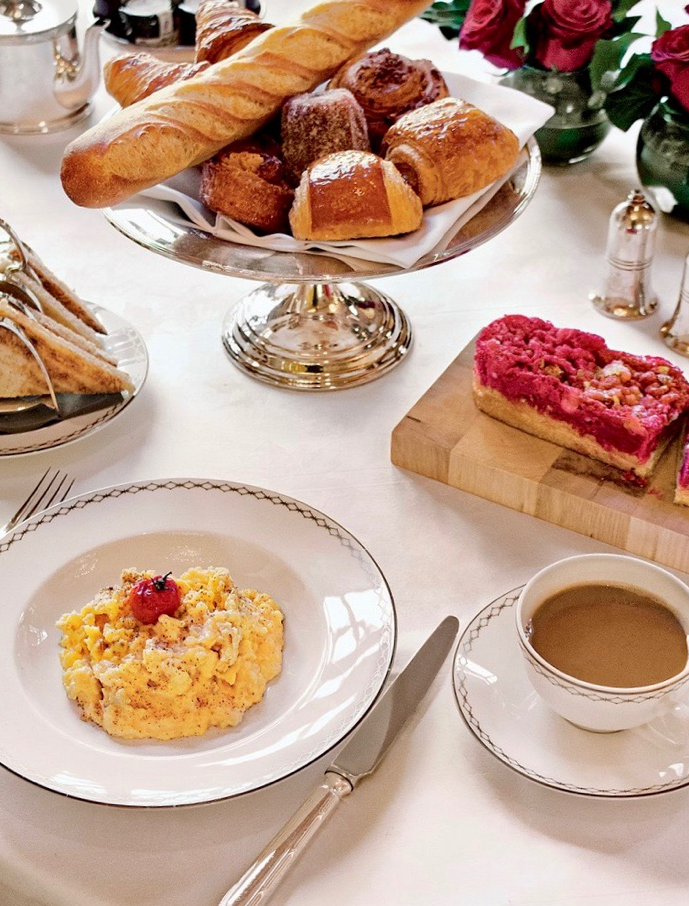Nothing says luxury to me like bread baskets, little jars of jam and ketchup, fluffy eggs, and a silver pot of tea served on a breakfast-in-bed tray. Here’s what you need to know about room service.

Pre-pandemic, I lived halftime in hotels and Airbnbs. My routine during the week was to write in the morning, then hit the town to see the sights, explore some shops, walk/ride a bike/find a gym before going out to an interesting restaurant. Sometimes, though, after weeks on the road all I wanted to do is stay in for the evening with Husband and Netflix. That meant room service.
Yes, it’s unspeakably expensive. Yes, it takes longer than expected. Yes, the quality of the food is usually not that great. (Although the room service breakfast mezze at the Grand Hyatt Istanbul was one of the best meals I’ve ever had.) And yes, apps like GrubHub and Uber Eats can offer delivery of less costly meals from local restaurants.
But even after years of travel, the novelty of staying in a fancy hotel, where you can swan around in a fluffy robe and slippers and have someone literally deliver food to your bed at nearly any hour, has never worn off. It’s one of those things that can make a vacation feel like a vacation.
(That said, enjoy it why you can. Started by the Waldorf Astoria New York in the 1890s, room service is heading for extinction. Every year more hotels are replacing it with well-stocked minibars, grab-and-go lobby pantries, and/or those above-mentioned outside delivery services.)
Once we are traveling again, if you want to go old school, here’s what you need to know about room service and tips to help make sure your delivered meal is a good one.
Dine in stages.
Don’t want melted ice cream for dessert? Order it after you’ve finished your main. If I’m not in a rush, I order in courses. The food will be at the right temperature, taste fresher, and the experience will feel more special. It also helps me eat less; by the time I’ve finished appetizers, I often realize I can pass on dessert. (If it’s been delivered, you can bet I’m eating at least some of it.) Often you can request your meal be served in courses when you place your order, or you can just make sequential calls.
DIY seasoning.
I order sides of Dijon, hot sauce, any fresh herbs, dried spices, sometimes mayo. If my food is dry or bland, I mix up a sauce to perk things up. And it makes a great dipping sauce for the fries I tell myself I’m not going to order but always do.
Talk to a person, not Alexa.
I know AI is the trend, with hotels installing tablets and smart speakers that allow you to adjust the lights and temperature, call up your car from the valet service, and order room service all without speaking with a human.
But a person in the kitchen can suggest side dishes, describe the daily specials, and tell you about options not on the menu. Sure, some options might be upsells, but you can always say no. And if you have dietary restrictions, talking with the kitchen staff is the best way to ensure your bread arrives gluten-free and your sundae without nuts. The culinary team may also suggest dishes best-suited for your needs.
Add a cocktail or glass of wine.
Do you usually have an aperitif or a glass of wine with dinner? No reason to do without if you’re ordering room service. If the hotel restaurant has a sommelier, ask to speak to them for a recommendation.
Choose the right dishes.
Know where you are and what the probability of greatness is. Venison steak would probably be a better choice in Colorado than Florida. Just as you should try to eat locally in restaurants, do the same when it comes to room service. Play to the kitchen’s strengths.
Because the covered room service tray traps heat, it’s effectively cooking your food in the time it takes to get from the chef’s hands to yours. If you order a steak medium, it might be medium well by the time it gets to you. While you can try to outsmart the lid by requesting your steak be cooked a notch lower than your preference, it’s not so easy to avoid overcooked fish, which will also probably stink up your room (as will blue cheese and onions).
Order chicken wings (which can be frozen raw or cooked) extra-crispy to be sure they’re cooked all the way through. Avoid anything with pesto (it may arrive crusty) or avocado (edible but turning an unappetizingly brown).
Crispy foods often will be soggy on arrival. If you must order fries, chunky cut are better than skinny ones. The “gourmet” pizzas are unlikely to be freshly made; frozen is easier to keep on hand for round-the-clock dining. (Don’t be fooled by those few torn basil leaves on top!)
Never order coffee; your pot will most likely be filled from an urn where the java has been brewing for hours. (Don’t be deceived by a French Press, either; to save time, shortcutting servers may fill it with the same burnt batch, too.)
Mind your manners.
Wear clothes when you open the door to your room service waiter. Bathrobes are clothes. Towels are not. Really.
Don’t put your tray into the hallway without calling down to the front desk to let them know it’s there. Other guests walking to their room don’t want to see your meal remnants. And don’t put your tray beside someone else’s door. No one cares that you had a midnight red-wine-and-French-fry attack.
Here are nine things to know before hitting the “Room Service” button on your hotel phone.
- Dishes are often priced higher on the room service menu than in the hotel’s restaurant.
In-room dining service charge and mandatory tip are ways hotels charge you for the pleasure of private dining.
- Room service food isn’t as fresh as in the hotel’s restaurant.
Most room service items are at least partially pre-prepared, as the room service kitchen or area of the kitchen dedicated to room service needs to have certain items ready ahead of time. If you really want to know what’s pre-prepared or dead easy to slap together, check out the night owl room service menu. Those dishes are designed so after-hours kitchen staff (or sometimes a desk clerk) can easily put them together.
- The hotel chef might not be preparing your food.
To cut costs, some hotels are opting to out-source their room service to local eateries. It might be “presented” by the hotel, but your burger could be from a restaurant down the street.
- The higher the floor the worse the food will be.
When a room service waiter takes a tray from the kitchen to your room, it’s typically covered in a metal lid to retain heat and prevent other guests from sneezing on it. The higher up you are, the longer it has to travel—and the more that lid traps steam, soaking your food in moisture. So forget crisp toast and crunchy fries if you’re on the 51st floor.
- Best dishes to order.
According to my unscientific survey of hotel chefs, the best items to order off room service are salads, a club sandwich, or a medium burger with American cheese on a toasted bun, lettuce and tomato on the side. (The toasting keeps the bread from being mushy upon arrival; serving them on the side means the veggies won’t be wilted.)
- Want breakfast on time? Fill out the door hanger card.
Checking off menu items the night before is a huge help to the kitchen pacing itself during the busiest room-service time of the day. And pre-orders are usually given priority to those phoned in that morning.
- You don’t need to tip the hotel employee who delivers your room service.
Read the bill before you sign it. In addition to the price of the food, there are often three tiers of service add-ons: a non-negotiable room service fee, an automatic gratuity (usually in the vicinity of 18%) that may or may not be negotiable, and a blank line for a “tip,” which is essentially a second opportunity to tip on the room service charge. Worried your tip won’t go to the person who actually delivered the meal? Most of the time, the service and delivery charges are given to the waiter or split between the people who answered the phone and pick up the tray.
- Consider non-room-service room service.
Many hotels now allow food deliveries from outside the hotel. In less-expensive hotels, there are often restaurant delivery brochures in guest rooms. In posher places, outside delivery is often banned (because the hotel doesn’t want non-guests in the halls for security reasons, empty pizza boxes cluttering the hallways, or competition for their in-house room service). A couple of times when I’ve wanted outside delivery (no room service kitchen can come close to vegetarian mu shu from a Chinese restaurant), I tell the front desk I’ll eat my ordered-in meal in the bar with a glass of their wine; no one’s ever refused this request.
- Room service can deliver more than food.
No, I’m not talking about drugs or hookers, although I’m sure those can be arranged at some establishments. Here are two of the more unusual offerings I’ve encountered:
–Pillow talk? At Seattle’s Kimpton Palladian Hotel, thanks to Husband, I found Tom Selleck in my bed. It’s not what you think: you can order pillows printed with images of celebrities (Brad Pitt, David Bowie, and Leonardo DiCaprio were also on the menu) from room service. If you become really attached to a certain star, no need to stuff him or her into your suitcase; the pillows are for sale in the hotel gift shop.

–IV, stat! The HGU New York will deliver any one of its range of IV infusion therapies to your room to fix what ails you, whether it’s jet lag or a hangover.

Twist’s Take: Order wisely, and room service is an indulgence that can make a trip extra-special. Breakfast in bed looking out over Venice’s Grand Canal or Abu Dhabi’s skyline makes the $15 fruit cup worth it.
